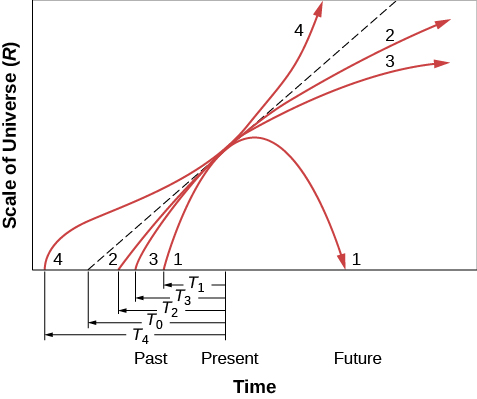| << Chapter < Page | Chapter >> Page > |

Let’s start with curve 1 in [link] . In this case, the actual density of the universe is higher than the critical density and there is no dark energy. This universe will stop expanding at some time in the future and begin contracting. This model is called a closed universe and corresponds to the universe on the left in [link] . Eventually, the scale drops to zero, which means that space will have shrunk to an infinitely small size. The noted physicist John Wheeler called this the “ big crunch ,” because matter, energy, space, and time would all be crushed out of existence. Note that the “big crunch” is the opposite of the Big Bang—it is an implosion . The universe is not expanding but rather collapsing in upon itself.
Some scientists speculated that another Big Bang might follow the crunch, giving rise to a new expansion phase, and then another contraction—perhaps oscillating between successive Big Bangs and big crunches indefinitely in the past and future. Such speculation was sometimes referred to as the oscillating theory of the universe . The challenge for theorists was how to describe the transition from collapse (when space and time themselves disappear into the big crunch) to expansion. With the discovery of dark energy, however, it does not appear that the universe will experience a big crunch, so we can put worrying about it on the back burner.
If the density of the universe is less than the critical density (curve 2 in [link] and the universe second from the left in [link] ), gravity is never important enough to stop the expansion, and so the universe expands forever. Such a universe is infinite and this model is called an open universe . Time and space begin with the Big Bang, but they have no end; the universe simply continues expanding, always a bit more slowly as time goes on. Groups of galaxies eventually get so far apart that it would be difficult for observers in any of them to see the others. (See the feature box on What Might the Universe Be Like in the Distant Future? for more about the distant future in the closed and open universe models.)
At the critical density (curve 3), the universe can just barely expand forever. The critical-density universe has an age of exactly two-thirds T 0 , where T 0 is the age of the empty universe. Universes that will someday begin to contract have ages less than two-thirds T 0 .

Notification Switch
Would you like to follow the 'Astronomy' conversation and receive update notifications?